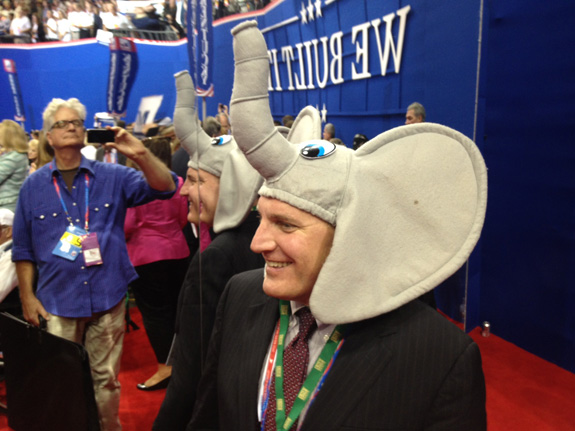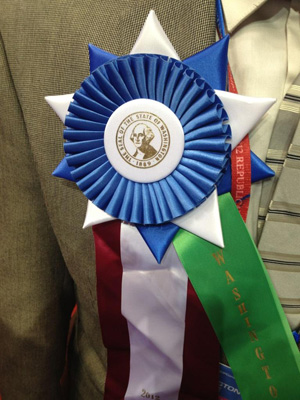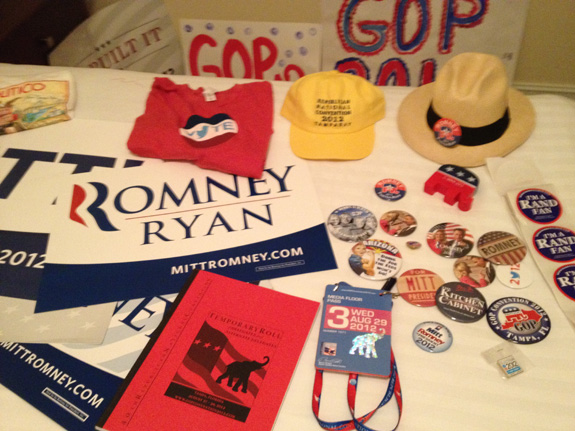What Do American History Museum Curators Collect at the Republican National Convention?
Follow the Smithsonian experts as they gather memorabilia in Tampa
![]()

Curator Larry Bird (at left, reflected) takes a photo of one of many unusual headpieces at the Republican National Convention
It takes a committed partisan to wear a funny hat or campaign button at a presidential nominating convention. But it takes two committed curators to plow through the convention crowds to collect the hats and buttons, plus the bumper stickers, lapel pins, party geegaws and discarded texts of speeches delivered in moments of extreme hope.
Larry Bird and Harry Rubenstein, curators at the National Museum of American History, have been navigating the crowds at both major parties’ conventions to collect such stuff since the 1980s—all to keep the museum’s political history collection of more than 100,000 artifacts current.
“We go to the conventions to sample and see,” says Bird, a Smithsonian curator since 1976. “We’re documenting the continuing American political tradition of how people elect a president.”
Of course that tradition has changed since the days of torchlight parades, and the pace of change has gotten faster since television became a force in presidential campaigns in the 1960s. But “even though the speeches come across on TV, there’s also this physical aspect to these events that can be very expressive and evocative and is not often covered by the news media,” says Rubenstein, a Smithsonian curator since 1982. “So this is another way of documenting these events. We want to cover all the bases on how people experience these things.”

The ribbon that caught the eye of the Smithsonian curator.
They flew from Washington, D.C., to Tampa for the Republican National Convention before Hurricane Isaac shredded the schedule for the first day, August 27, but they still showed up for the abbreviated 10-minute opening session. “We were there to see the gavel drop,” Bird says, “but it was the strangest experience, because there were no delegates.”
But for Wednesday’s session there were delegates, and one of them was wearing something that caught Bird’s eye. “There was a Washington State delegate with a very elaborate ribbon—it was huge, took up half his lapel and it was made of different-colored ribbons. The center it had the seal of Washington State.” Another member of the Evergreen State’s delegation, a jeweler, had custom-made that one and several more for his fellows. “When you see something like that, you know they’re acting out a process of activism and engagement that’s deeply embedded in that ribbon,” Bird says. He was offered one on the spot, but chose to arrange to have it sent to him after the convention so it wouldn’t get crushed.
“It was a nice piece,” Rubenstein says, but he prefers to sift through everything they gather after the fact. On Thursday, the eve of the Republicans’ last day, he and Bird had collected about 30 artifacts, but they had arranged for many more to be sent after the fact.
Both curators say context matters when they’re considering what to collect. Bird recalls that when he went to his first nominating convention, the Democrats’ gathering 1984, he kept asking himself, what is the one thing that sums up what’s going on? The day after the convention closed he found remnants of Walter Mondale’s acceptance speech, including the line saying he—unlike his opponent, President Ronald Reagan—would admit he’d raise taxes. Its significance became a lot clearer after Reagan won with almost 59 percent of the popular vote that November.
Since then, Bird notes, buttons and bumper stickers have been supplanted by TelePrompters and Jumbotrons, “but the ability to project an image of a candidate is the constant, really—finding some logo that will speak to the broadest part of the electorate.” And so their search continues.
After Mitt Romney formally accepts the Republican nomination tonight, Bird and Rubenstein will drive to Charlotte for the Democratic National Convention next week and then head back to Washington. “And then,” Rubenstein says, “we’ll try to make sense of it all.”
